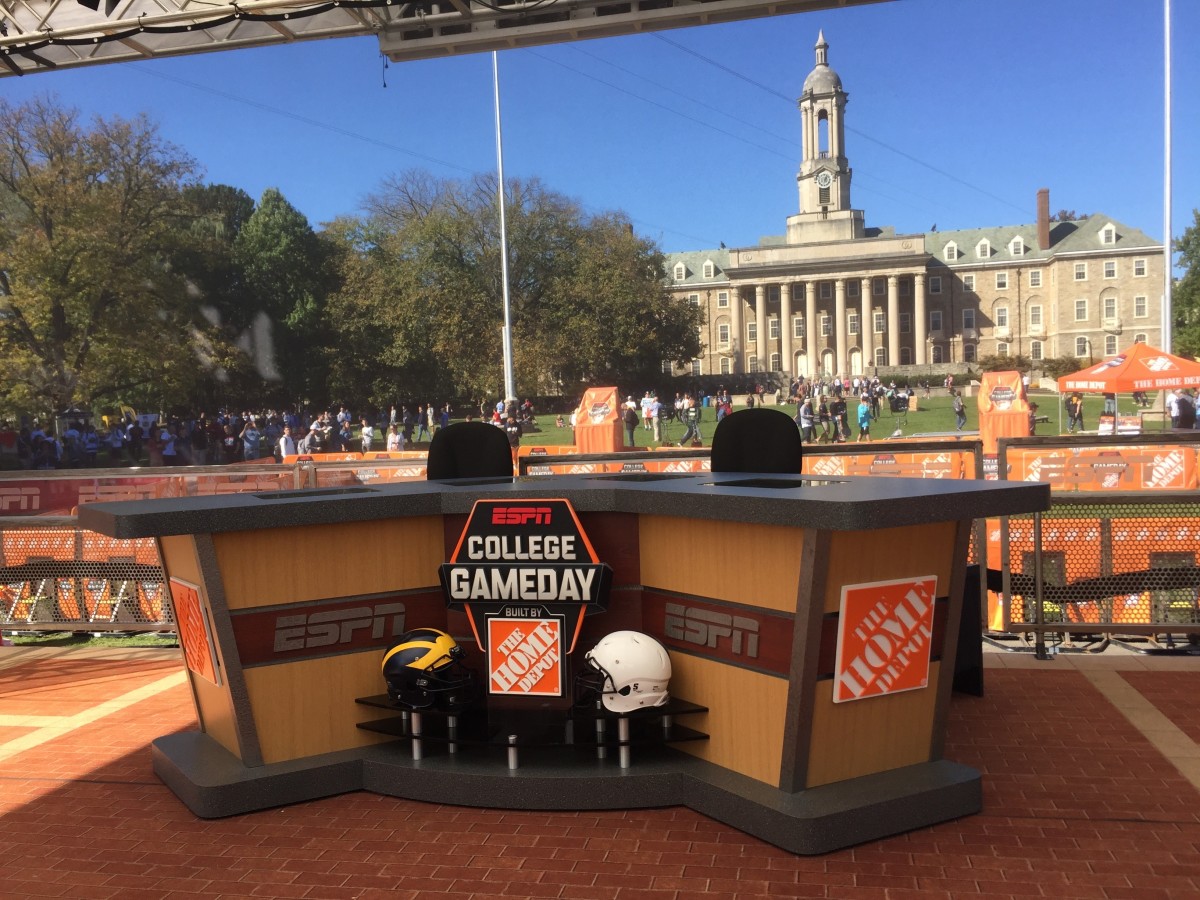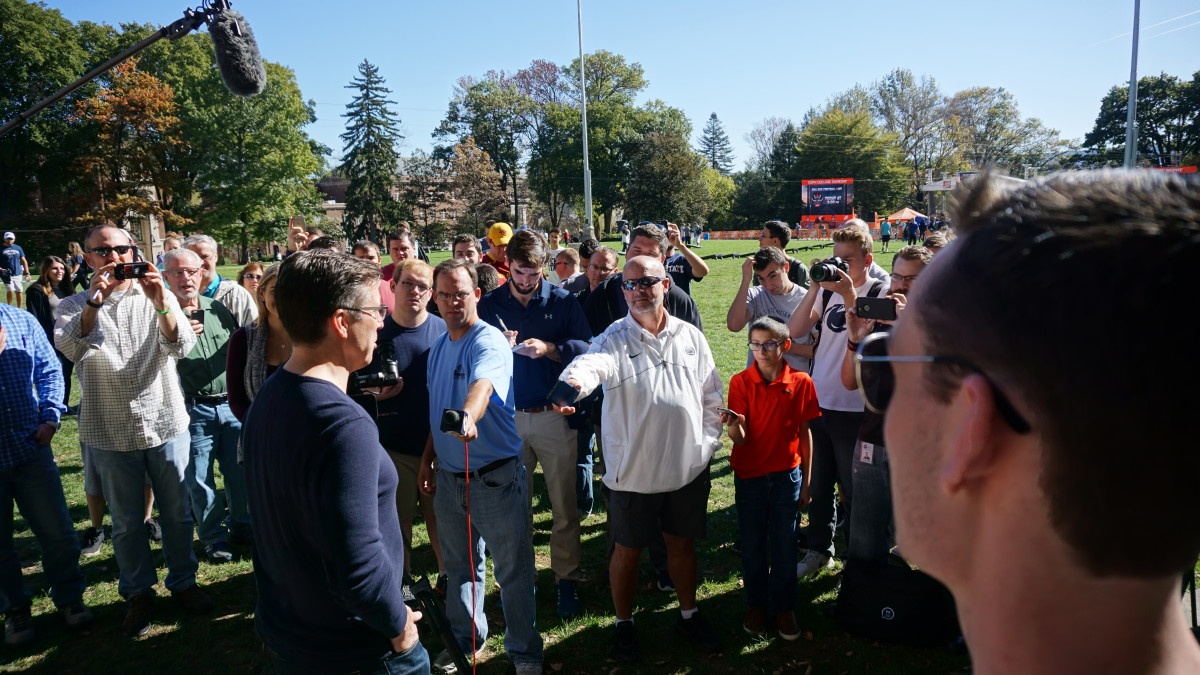Behind the Scenes at ESPN's College GameDay

College GameDay is ESPN's iconic show that airs every Saturday morning during football season. You may know it as the show on which former coach Lee Corso picks the winner of the featured game by putting on the mascot’s head. Or you may remember it because the fans are piled up behind the set, and the craziest of the crazy of them arrive at 4 a.m. (or earlier) to get those seats, no matter the weather. The rest of the fans carry signs (sometimes larger than themselves) that insult or make random accusations (true or untrue) about opposing coaches, make fun of cast members, and other silly things.
I attended the Michigan-Penn State game on October 21 in State College, Pennsylvania, and went to GameDay that morning. The day before, I spoke with a number of announcers, including Kirk Herbstreit, Desmond Howard, Rece Davis, and David Pollack, about what it’s like being on the show, what life is like on the road, how campuses impact the production, and what they enjoy about being part of it.
One of the central aspects of GameDay is that each week it’s in a different location. There are some places that the show visits regularly, such as Tuscaloosa (Alabama), Columbus (Ohio State), and Death Valley (Clemson); while other places don’t get it as often, such as Happy Valley (Penn State) and Ft. Worth (TCU).
ESPN’s State College “war room” was a single room in the Old Main building, which is an administrative office on campus. The lawn in front of Old Main was where the set was located. There, I spoke to a pair of producers—Jim Gaiero and Drew Gallagher— about the production of GameDay.
Gaiero explained that they try to go to “the best game possible but also make sure [they] get the best scene possible.” This is why they went to James Madison University (JMU) in Harrisonburg, Virginia, in mid-October for the first time since 2015 and the second time ever.
Pollack, one of the show’s analysts, said that when GameDay goes to a new school, the level of enthusiasm reaches new heights. “James Madison was nuts,” he said. “TCU was nuts because they don’t get it very often.”
Gaiero added that regardless of the how often the show visits a campus, each production is different. “Even though we go to Alabama every year, we always find something new to do,” he said. “New ways to interview coach [Nick] Saban, stuff like that.” He emphasized the need to “keep it fresh.”
At some campuses there may be more than one place to put the set, and that matters to the crew. Derek Volner, the communications manager at ESPN, explained that at Penn State, the wide-open, mostly flat lawn in front of the Old Main building where the set was located was perfect. There are other schools where the set is at the bottom of a hill, and students are standing at the top, looking down.

Whenever GameDay goes to a school multiple times, the crew tries to change the set’s location on campus. In addition, Herbstreit explained that in the past five to seven years, the show had been working on finding locations that give more of a collegiate feel.
Cast members explained that they really appreciate the energy from students and fans, and that State College was a terrific example of that. Speaking casually with local media in shorts and a T-shirt, Herbstreit explained, “When you have passionate fans and a great team, it just makes for a chaotic scene around the set.” Pollack and others echoed this, saying that they like to travel to different places each week.
Campus showcasing is important for the people who plan the show. Gaiero gave a handful of examples from the past few weeks, saying that at Penn State they wanted to go to the Creamery, a landmark at the school famous for its ice cream. At JMU they were able to add a historical element to the show, and at TCU they were situated in the middle of the dorms, so there were students hanging out of the windows.
One of the primary things I was interested in was how the campus is chosen each week. Gaiero explained that the crew has a general idea of where it would like to go next, with a list of two or three places. Once the show is over, everyone heads to the trucks and watches the day’s games. The selection process for the following week’s location happens that night after Herbstreit and Chris Fowler finish their broadcast. Everyone is texting, saying where they want to go, and by the wee hours of Sunday morning, they’ve made their decision.
Gaiero said that the show location “isn’t impacted by rivalries; it’s impacted by what’s going to be the best show and what’s going to be the best matchup.” When I spoke to him Friday around lunchtime, he informed me that if the Nittany Lions beat the Wolverines (they did), then the show heading to Columbus the next weekend was still a possibility, even though it would be the second time GameDay traveled there this season and third time the featured game involved Ohio State. (GameDay did end up in Columbus.)
While rivalries don’t always dictate where the show goes, they aren’t ignored altogether during the broadcast. The analysts still spoke about the Alabama-Tennessee game (even though the Volunteers aren’t as good as they used to be) and ran a pair of segments involving the Notre Dame-USC game, including an interview with Trojans quarterback Sam Darnold.

Pollack explained that he likes rivalry games because “it doesn’t matter what your record is, and I know that sounds very cliché, but it’s true. It’s hard to get up when your team stinks, especially when your expectations are high. But when you have a pure hatred for the other team, you get up regardless.”
He cited the rivalry game he played in, pitting his alma mater (Georgia) against Florida, saying, “Florida isn’t very good. Georgia’s very good. Doesn’t mean Georgia is gonna win. Florida will be ready to play that game (…) [In] rivalries there is always a little something-something extra to it.”
To prepare for the show, Pollack said that he watches a lot of tape. “It’s about getting a good pulse of what the team does,” he said. Pollack used Penn State’s Saquon Barkley as an example, saying he looked at tape of the running back to find out “why he does certain things well.” Pollack went on to say that on the show, he was in charge of breaking down Michigan’s defense and explained what he would do to stop Barkley in addition to Michigan’s strengths and weaknesses on defense.
“The only way to do that is to spend hours and hours and hours watching tape and watching games,” he said. For him, that means watching footage for up to six hours a day.
Being on the road for a quarter of the year is hard. Gaiero has a four-year-old daughter whom he can’t see during that time. Pollack has two young children. Herbstreit has four. The 82-year-old Corso, who suffered a stroke in 2009, had to learn how to talk again and needs to memorize a script before the broadcast. It’s a lot, but as Pollack and Gaiero explained, the people who work on College GameDay are family to each other, and the time I was able to spend with them confirmed that.
At the end of the show the Saturday of the Michigan-Penn State game, Corso made his 302nd pick. He grabbed a Wolverines helmet, started to put it on, then threw it to Howard and put on a big Nittany Lion head. The crowd went berserk.
Photographs by Hayden Goldberg
